National Aeronautics and Space Administration
Goddard Space Flight Center

Sun-Earth Day 2009: Our Sun Yours to Discover
Issue #67: Happy Anniversary!!!
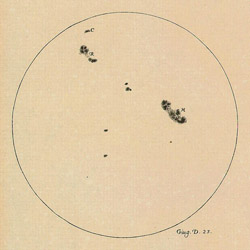
Figure 1: Galileo's sketch of sunspots (Galileo, 1610)
Anniversaries come and go, but some of the ones in the science of heliophysics are particularly noteworthy.
Over the centuries, there have been many important moments in the discovery of our sun as a star, and its influences upon Earth. This year, 2009, marks an interesting confluence of several of these important anniversaries in our understanding of the sun-earth connection. It is the 400th Anniversary of Galileo Galilee having first sighted sunspots in 1610 using a telescope barely more powerful than a good pair of modern binocular. But his hand-made telescope was more than enough to glimpse spots on the solar surface, and dash any remaining expectation that the sun was a Perfect Orb, made of celestial luminous matter.
It is also the 365th Anniversary of the start of the Maunder Minimum: a period of extremely low solar activity, that lasted from 1645 to 1715 when the sighting of Galileo's sunspots was a very rare event, despite the intense scrutiny that even newer telescopes brought to bare on the solar disk.
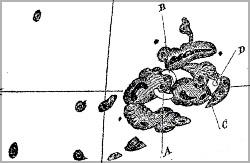
Figure 2: A sketch of the Carrington Flare spotted on September 2, 1859 during the second phase of the Great 1859 Superstorm. (Carrington, 1860)
It is the 150th Anniversary of Astronomer Richard Carrington's having observed a solar flare in 1859. The intense calamity that this spawned in the newspapers, and the many telegraph outages that followed the geomagnetic storm, was enough to turn scientific attention to the connection between the sun and earth in the hope of being able to predict when the next cosmic storm might once again distrupt telegraph systems.
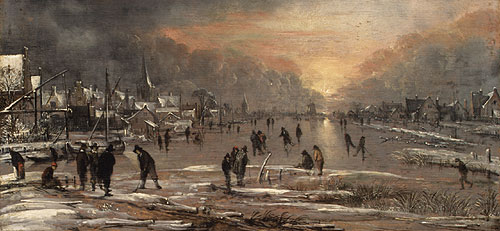
Figure 3: Maunder Minimum - The Maunder Minimum, when few sunspots were observed for nearly 70 years, was also the Little Ice Age in Europe when ice skating on the Themes River in London became popular. This painting, "Sports on a Frozen River" by Aert van der Neer shows a typical scene. (Courtesy: The Metropolitan Museum of Art)
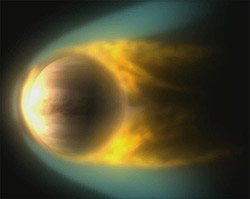
Figure 4: Mathematical model of Venus and the solar wind as it blows-back the atmosphere of Venus (Courtesy ESA)
This year also marks the 50th Anniversary of Physicist Eugene Parker having described the solar wind in a detailed mathematical model, which began with the heating of the solar corona and its outflow at super-sonic speeds into the depths of the solar system. As it brushed by planetary atmospheres and magnetospheres, it forced them into a variety cometary forms. At this same time, Physicist Thomas Gold defined some of the features of Earth's magnetosphere and coined this term for the first time.
It is also noteworthy to celebrate, if that is really the correct term to use, the 20th Anniversary of the Blackout in Quebec, Canada that was caused by a geomagnetic storm - (see Hinode vodcast)
The Sun-Earth Connection
The history of our growing understanding of the sun-earth connection is marked by many important anniversary years. This year, 2009, is an unusual combination of these important events in history.
Space Math Connection:
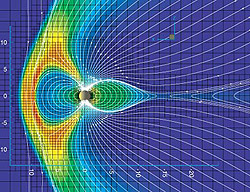
Figure 5: The magnetosphere defined by a mathematical model. (Courtesy: University of Michigan)
These problems are available at Space Math @ NASA (http://spacemath.gsfc.nasa.gov)
Monster Sunspots [Problem 107]
Some sunspots are so big that they can be seen from Earth without a telescope. In this problem, students will use images of three super-spots and calculate their sizes from the image scaling information. They will then order the images from the smallest super-spot to the largest super-spot. [Skills:multiplication; calculating length from image scale]
Predicting the Next Sunspot Cycle [Problem 100]
Students examine a plot of the sunspot cycle and extract information from the plotted data about the previous sunspot cycle. They use this to make predictions about the next sunspot cycle that began in 2008. [Skills: graph reading; extrapolation; time calculations]
The Distance to Earth's Magnetopause [Problem 25]
Students use an algebraic formula, and some real data, to calculate the distance from Earth to the magnetopause, where solar wind and Earth magnetic pressure are in balance. [Skills: evaluating equations numerically; scientific notation; unit conversions; Excel Spreadsheet manipulations]
References:
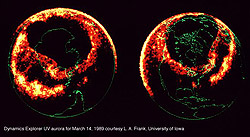
Figure 6: The Quebec Electrical Blackout of 1989. Dynamics Explorer ultraviolet image of the aurora of March 14, 1989
SED-2007 - Solar Science:
- TTT 48 - The Sun from Cradle to Grave
- TTT 49 - Solar Energy
- TTT 50 - Ancient Sunlight
- TTT 52/6 - Solar activity and features
- TTT 57 - The Heliosphere
SED-2008 - Space Weather Around the World:
- TTT 58 - Why is the sun's corona hot?
- TTT 59 - Where did all the neutrinos go?
- TTT 60 - Where does the sun's magnetic field come from?
Credits:
Dr. Sten Odenwald (Author - Hinode)
2009 ISSUES
View past issues
NASA Fact
The most powerful solar flare in the last 500 years occurred on September 2, 1859 and was sighted by two astronomers who happened to be looking at the sun at exactly the right time!
